Diving - The adventure continues!
2024 Diving
With our (nearly) annual trip to the wrecks and reefs of Plymouth looming up, I thought it advisable to give my twin setup a run out, especially as I had added a Remote Lead (better known as a 'slob knob') to the isolator valve on the manifold (If you don't know what that all means, don't worry).
Ideally, I'd have gone to Vobster, but I didn't have the time, so I joined our chief instructor, Caroline, and SD trainees, Seadnha and Piers at Wraysbury instead.
It was a lovely sunny day and I very quickly regretted wearing my thick undersuit, so I chose to dive hood and glove free.
You can forget how heavy a twinset is out of the water, but once in the water, it's easy to forget you have them on.
I dived with Seadnha and for our first dive, we walked in behind the shop and headed left.
Vis wasn't great (it was a Sunday) even though we were amongst the first in, but we found ourselves at the pit and descended into it, finding it totally dark at the bottom.
Regrouping at the edge, we headed out across the lake, but for most of the dive, we didn't see much, although on the barren lake bed the vis was far better for the most part, which made the diving more enjoyable.
We did spot quite a few Perch, both adult and juvenille, and the usual large number of Crayfish.
Some video from the two dives
Seadnha reported that his drysuit was flooded on exiting the water, and I could see the bottom of the suit was full of water.
It turned out he'd gone in with his back zip wide open! To his credit, though, after drying out in the sun for about an hour and a half, he was keen to do a second dive.
We entered from the pier in the car park, with the aim of finding the aircraft section.
I quickly found the first small boat and the diving bell, now lying on its side and cut open for penetration and safe egress.
We had a swim through there and then generally swam around.
Just when I was giving up all hope of finding the plane, we came across it and explored it for a few minutes (it doesn't really change).
I can usually find a fair number of wrecks from the plane, but on this occasion the vis was so poor (and I had no compass!), that I didn't see any other wrecks and eventually, unsure of where we were, we surfaced and found ourselves roughly in line with the shop, but on the far side of the lake.
We surface swam from there and exited up the ramp, after watching a big shoal of juvenille Perch under the pier.
The twins and my regs were fine and the 'slob knob' posed no issues for me to dive. Next stop, Plymouth!
Plymouth - Wrecks galore
9 of us converged on Plymouth at the end of June. Ollie had arranged the trip this year and we were staying at the Mount Batten centre and diving with In Deep, the dive operator based there.
This gave us numerous benefits; Free parking, free air and half price nitrox, being co-located with the boat each day and cheap accommodation, compared with staying in Plymouth centre. We paid a fairly paltry £250 each for two nights B&B and two days diving, which was cheaper than previous trips had been.
John drove us down (a relief to me as I picked up TWO speeding tickets on a previous visit!) and we arrived around 4PM, in time to get my twins filled with 30% nitrox and a 15L cylinder filled with air.
The accommdation was comfortable enough, except that it was very hot and stuffy in the good weather. We shared rooms for the price we paid, but singles are available.
We took the ferry across to the Barbican and, on the recommendation of a couple on the boat, ate at The Village Restaurant, which turned out to be an excellent choice!
Despite the heat in the rooms, we did get some sleep though and after a good breakfast, loaded up the boat, Panther, for the trip out to our first dive site, the Persier.
We'd hoped to do the Maine, but were told that the tides didn't work that day, but to be honest, I just think they dislike going to the site as it is a long way out and often hard to dive, due to its location.
As it turned out, diving the Persier again on this trip was no hardship as, despite being around 30M deep, the vis and light on the wreck were excellent.
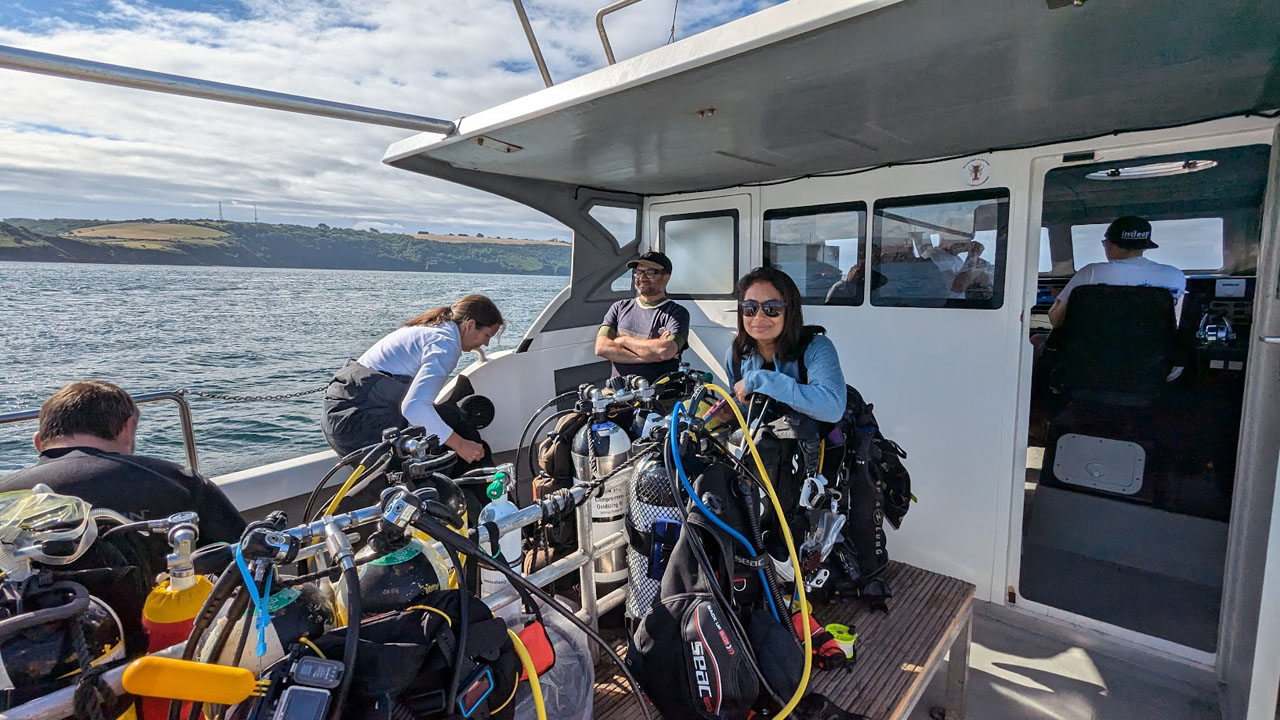
Happy divers heading out for the first dive.
I dived with Ollie and Kim (Phil, who was slated to be Kim's buddy, called in sick for the weekend),
The crew had shotted the boilers and we swam around those for a while, admiring some congers and lots of Bib around and in them, before heading off towards the stern to see the propellor and rudder.
As we crossed the broken engine crankshaft, I spotted movement out of the corner of my eye and saw a decent sized Conger swimming around, seemingly looking for a new place to shelter.
The dive on the Persier
We moved on down the ship, passing over the mainly flattened hull until we reached the stern, where there is a prominent steering quadrant, the large rudder lying on the seabed, with enough space to swim under it and a gun mount, now sadly without its gun.
We turned back along the wreck and passed over the boilers, heading for the bow, which we eventually reached, spotting the anchors and then, now with deco to do, started our ascent.
Ollie and I had nitrox, but Kim, who'd expected to dive with someone else, had air and so we had quite a long wait for him to complete his deco stop.
Back on the boat, everyone was chatting excitedly about a great dive.
Warm drinks and pasties were handed out and we headed back on the direction of Plymouth, having agreed to try a new wreck to most of us, the small HMT Elk.
I'd often heard people speak of it as an excellent dive, but had never dived it myself as far as I could remember.
We topped up our twins from our spare cylinders, but were always going to be a bit limited on dive time on a wreck at 34M.
We dropped in, but my wing inflator hose fell back over my shoulder, out of reach, so it took me a little while to catch up with Ollie and Kim.
As I did so, I could see them hovering just off a small wreck which was all visible from 10M above.
We dropped onto it amidships where a large winch is one of the few pieces of deck hardware still visible.
The hull, though, for a WW2 wreck, is impressively intact, with plenty of opportunity to swim below the deck level, although being a small trawler originally, it only stands a couple of metres off the seabed at most.
The dive on the Elk
We spotted some enormous lobsters on the wreck, but I only saw one Conger, whereas Ria reported seeing over a dozen!
Once again, though, everyone enjoyed the dive immensely and we returned happy.
After dropping our cylinders for a refill, showering and having a post dive drink, we all headed back to the Barbican on the ferry to have a curry in an Indian restaurant I'd been to before, the Himalayan Spice.
Reviews were still good and we were seated at a large table near the back of the, generally, tiny restaurant.
With three Indians with us, the pressure was on, but they all praised the food and everyone had a great time.
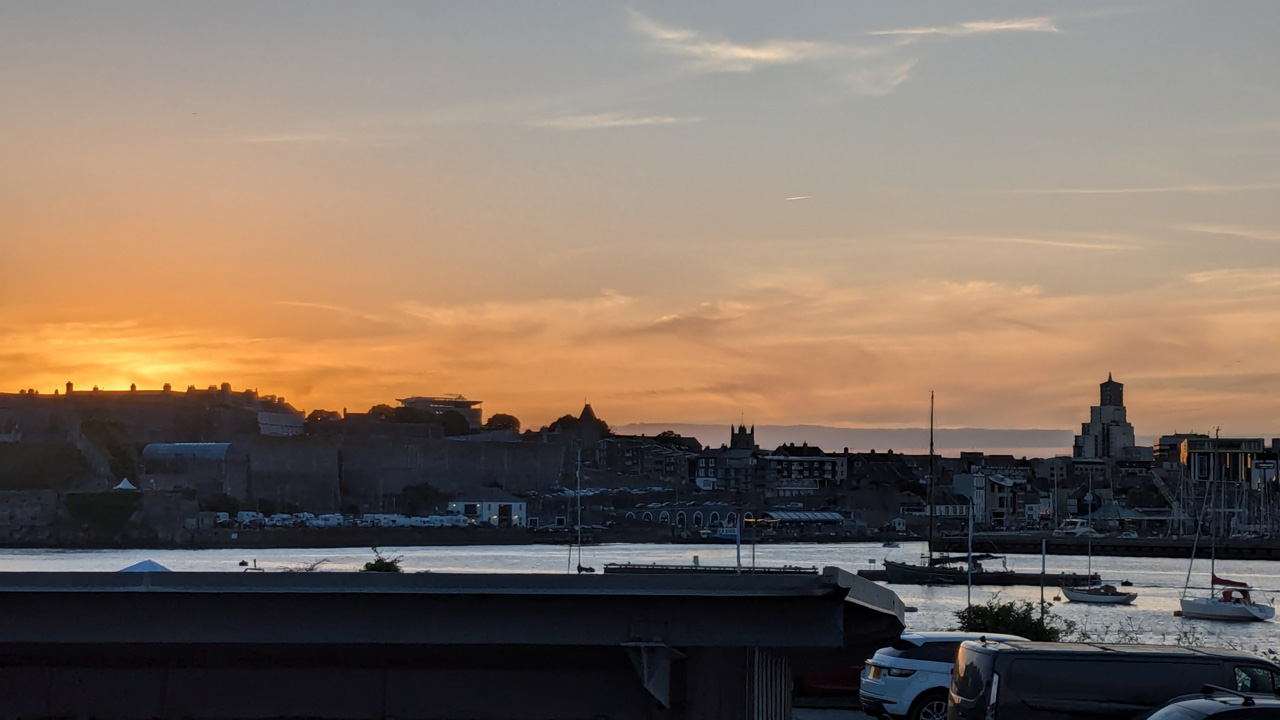
Lovely weather lasted into the evenings
The next morning we were asked to be at the boat for 8, but in the end we all had to wait around until after 9, as there was much delay with getting gas out to the many people diving, due, we were told, to the regular man phoning in sick.
When we finally got going we headed out, first, to the Rosehill.
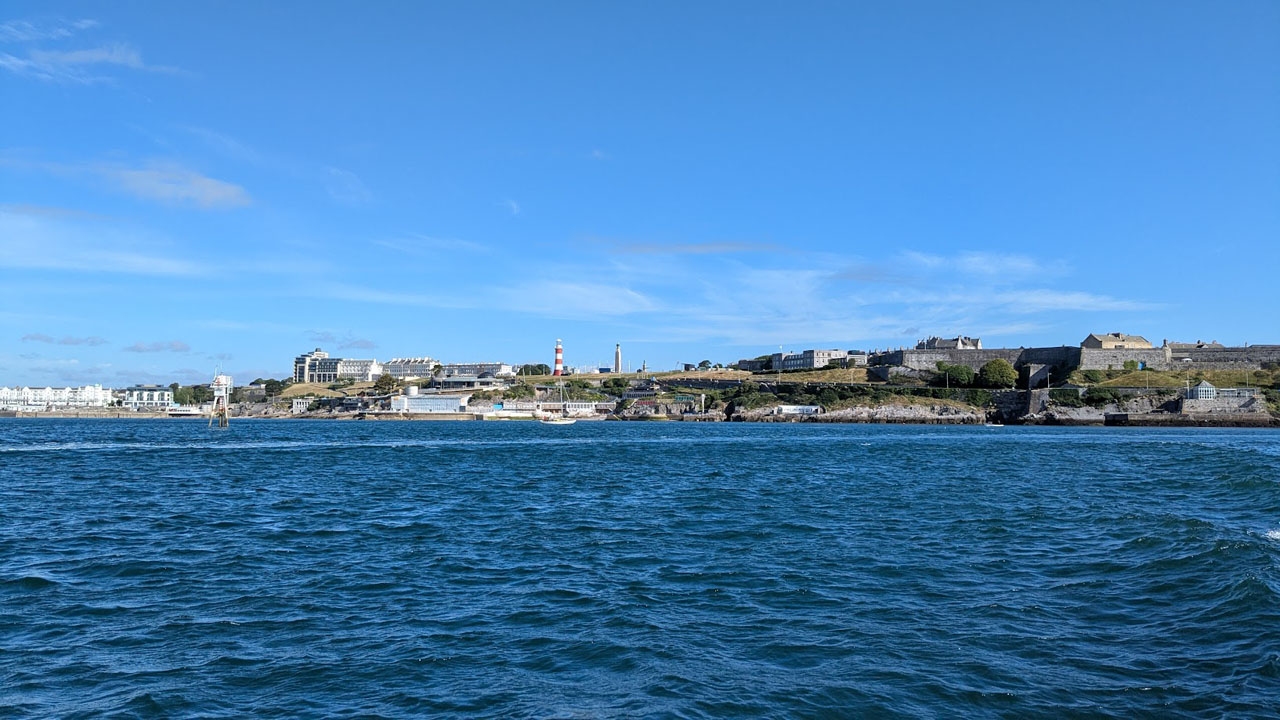
Good weather over Plymouth Hoe as we head out on day 2
We'd dived this a few times before, but I find it a more interesting wreck than the James Eagan Lane, which was the alternative.
It took the crew a few attempts to shot it, they initially used a (rather light looking) grapnel, which refused to hook in, but once they put a lump weight on the line it was shotted immediately, right next to the impressive boilers.
We started there, once again spotting loads of fish and some Congers inside.
From there, we headed to the stern, where I know we would find the gun, still in place.
The dive on the Rosehill
The wreck, much like the Persier, is much flattened, but looking under plate edges usually rewards you with some kind of interesting life lurking there.
We passed a large winch along the way and then reached a cage with a large universal joint on a propshaft inside. Just behind this was the still present three bladed iron propellor, with one blade pointing skyward, although Ollie somehow missed it entirely!
Close by was the rudder, steering gear and the gun, which, in the excellent vis, was more apparent and clear than I'd seen it before.
We headed back to the boilers from there, passing them and eventually reaching the bow, where we found the anchors at which point we decided to end the dive, with a little deco, and head for the surface.
With us all on the same gas (32%) today, the deco was shorter and we still had a reasonable amount left for the final dive of the weekend.
That dive was to be on HMS Scylla.
The Leander Class frigate has been in Whitsand Bay for 20 years now, and I have dived it for 12.
When I first visited it, there were definite walls and corridors visible just from looking inside and the hangar had, I'm sure, a roof still.
Until my last visit, the bridge had a roof, with just a hole cut out for access, so I was a bit surprised to find the roof had completely collaped!
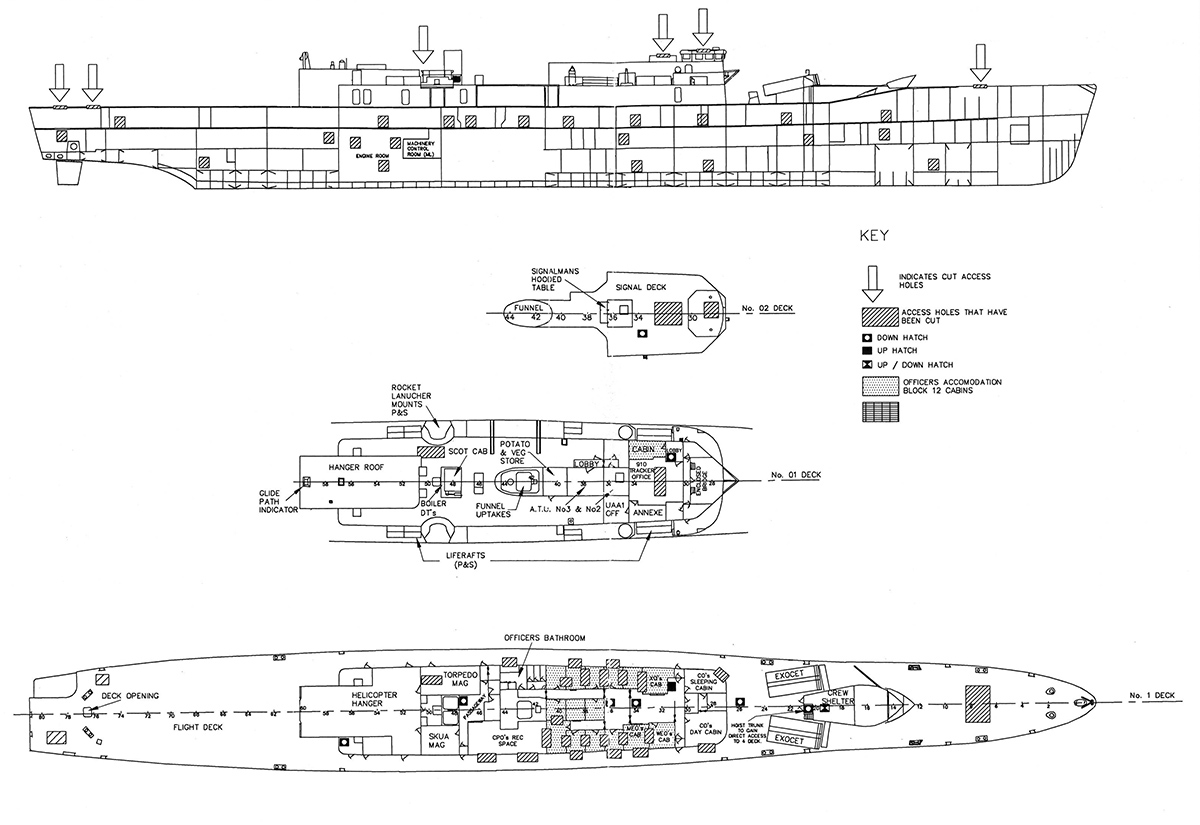
Scylla schematic - Courtesy The SHIPS project
What had been a small staircase down into a room on my early visits, is now just a drop down to an open area below and behind the bridge.
We swam out onto the bow, looking at the Exocet launchers and then dropped over the starboard side and headed back until I spotted an opening that looked promising and swam inside.
My initial thought, as neither had been in a wreck to my knowledge before, was to swim across, but there was so much light, and so many internal walls have now corroded to nothing, that I could clearly see the full length of the deck out to the helicopter deck, so I weaved my through the skeletonised wall and out onto the flight deck.
We dropped over the stern and swam under the wreck, where there were many fish sheltering and then swam up to another opening.
We swam across a room in one of the lower decks and then up to another, where I could see machinery through a collapsed wall.
The dive on the Scylla
After a bit of reconaissance, I decided I could get through what I thought was the engine room if I could wriggle in.
I did so and we swam over and around the machinery to the exit on the port side.
Further up the wreck, I swam in and we went up the funnel opening before exiting onto the top of the ship.
Our final penetration, took us along a corridor towards the bow, where, after passing a warning sign about wreck penetration, we exited via an opening on the top of the bow.
At that point, Kim and I were getting a little short on gas, so we deployed our DSMB and headed up, only needing a safety stop on this relatively shallow dive.
Everyone had enjoyed the Scylla (some divers are sniffy about it being a deliberately sunk artificial reef, rather than a 'real wreck'), but I reckon it was the best dive I'd ever done on the wreck.
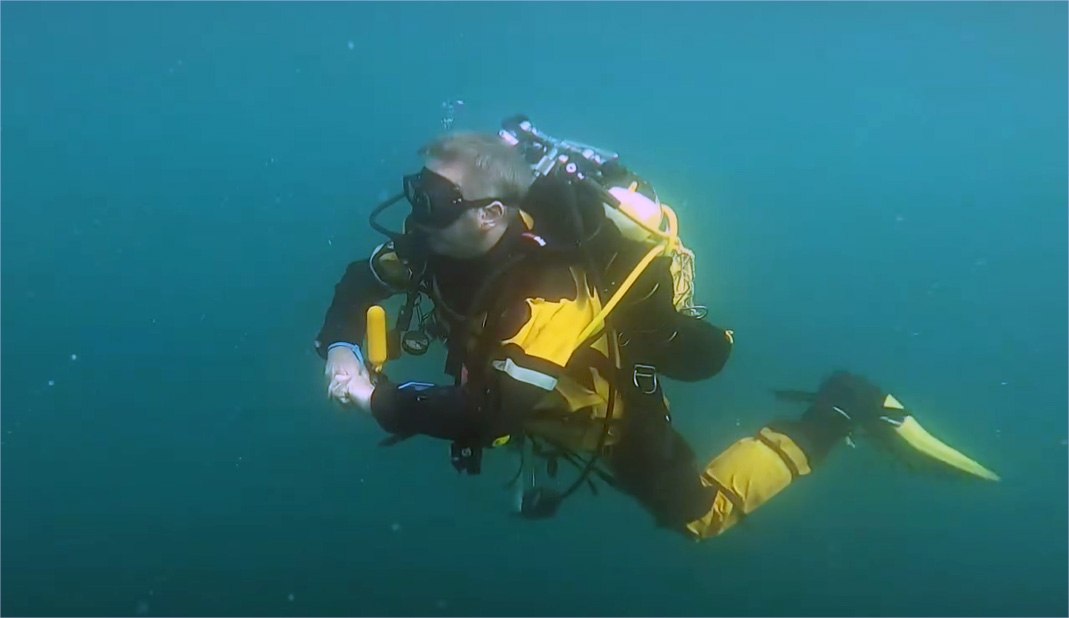
Deco stop on the Rosehill, even at 30M we didn't need hoods and gloves - Still from Ollie's video
Every time I go, I observe that it's falling apart, and it was noticeably more broken down than on my last visit two years ago, but this, combined with good light, meant that we could penetrate various decks far more easily and safely than had been possible in the past.
Sadly, it probably won't be long before going in will be very dangerous as the hull starts to collapse, but on this trip, the wreck was our oyster!
The journey home was less traffic heavy than on the way down (often the way, it seems) and I was home by around 7PM.
Afterwards, everyone was very positive about the weekend and the dives and those of us who have been to Plymouth numerous times agreed it was amongst the very best Plymouth weekends we had enjoyed.


